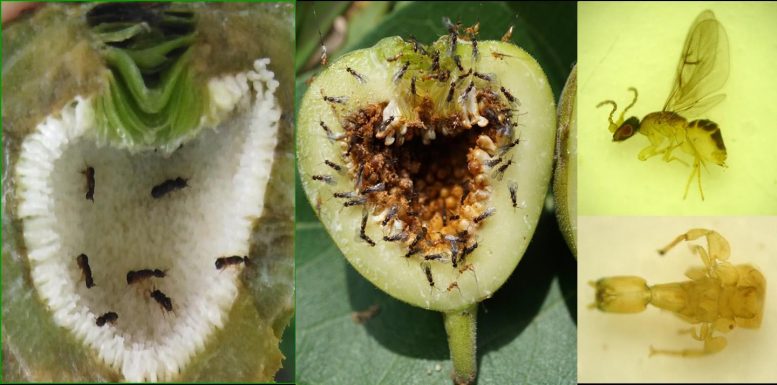
Banyan trees are fig trees that begin their life as an epiphyte. The most noticeable feature of banyan Ficus species is their extraordinary aerial roots, which enable them to live as hemi-epiphytes, as do the strangler figs often seen in tropical forests.
Being special for their enclosed urn-shaped inflorescence, fig plants rely on specific insect pollinators (fig wasps) for pollination and, in turn, provide nourishment and shelter for pollinators to reproduce. Morphological matching and signaling communication for host location between figs and their pollinators is required for successful pollination and oviposition.
This obligate mutualism is a fascinating case of extreme plant-insect codiversification.

In a study published in the journal Cell, researchers from Fujian Agriculture and Forestry University (FAFU) and the Xishuangbanna Tropical Botanical Garden (XTBG) provided insights into fig-wasp coevolution through comparative analyses of two Ficus genomes – one with aerial roots and one without, one monecious and one dioecious, as well as the genome of a coevolving wasp pollinator. They also sequenced more samples of figs and pollinators.
The researchers sequenced genomes of the monecious Chinese banyan tree, F. microcarpa, and a dioecious species lacking aerial roots, F. hispida, and one wasp genome coevolving with F. microcarpa, Eupristina verticillata. Comparative analysis of the two Ficus genomes revealed dynamic karyotype variation associated with adaptive evolution.
“We quantified endogenous auxin in F. microcarpa and F. hispida, and proposed that an auxin-dependent pathway promoted by light is associated with aerial root initiation, growth, and pattern formation,” said WANG Gang, associate professor at XTBG and co-first author of the study.
Furthermore, the researchers constructed an ultra-density F1 paternal genetic map and Hi-C chromosome for studying sex determination and sex evolution in Ficus plants. They found a nascent Y chromosome in F. hispida and a male-specific AGAMOUS paralog, the FhAG2 gene, as a candidate sex determination gene of this fig species.
“We also established a phylogeny of Ficus by using data from resequenced genomes of 112 Ficus accessions comprising 62 Ficus species. Our phylogenetic analysis revealed that monoecy represents the ancestral reproductive system across the genus,” noted the study.
Lastly, the researchers investigated a potential molecular mechanism of coevolution between 14 fig species of the subgenus Sycomorus and their obligate pollinator wasps. They identified candidate genes that had undergone selection, and the species-specific signaling compounds that were essential for communication in three fig-wasp species pairs.
“Population genomic analysis of subgenus Sycomorus figs and their obligate pollinator wasps and electrophysiological testing of pollinators responding to floral scents emitted from three different Ficus species support the important roles of the mevalonate and shikimate pathways in attracting species-specific pollinators and reveal potential molecular mechanisms of codiversification in this obligate mutualism,” said WANG.
“The work, integrating efforts from several universities and institutes from China and overseas, particularly the expertise on genomic analysis from FAFU and fig biology from XTBG, will enhance our understanding of the species-specific mutualism between figs and fig wasps,” said CHEN Jin, one of the corresponding authors of the study.
Reference: “Genomes of the Banyan Tree and Pollinator Wasp Provide Insights into Fig-Wasp Coevolution” by Xingtan Zhang, Gang Wang, Shengcheng Zhang, Shuai Chen, Yibin Wang, Ping Wen, Xiaokai Ma, Yan Shi, Rui Qi, Yang Yang, Zhenyang Liao, Jing Lin, Jishan Lin, Xiuming Xu, Xuequn Chen, Xindan Xu, Fang Deng, Lihua Zhao, Yi-lun Lee, Rong Wang, Xiao-Yong Chen, Yann-rong Lin, Jisen Zhang, Haibao Tang, Jin Chen and Ray Ming, 8 October 2020, Cell.
DOI: 10.1016/j.cell.2020.09.043
Never miss a breakthrough: Join the SciTechDaily newsletter.